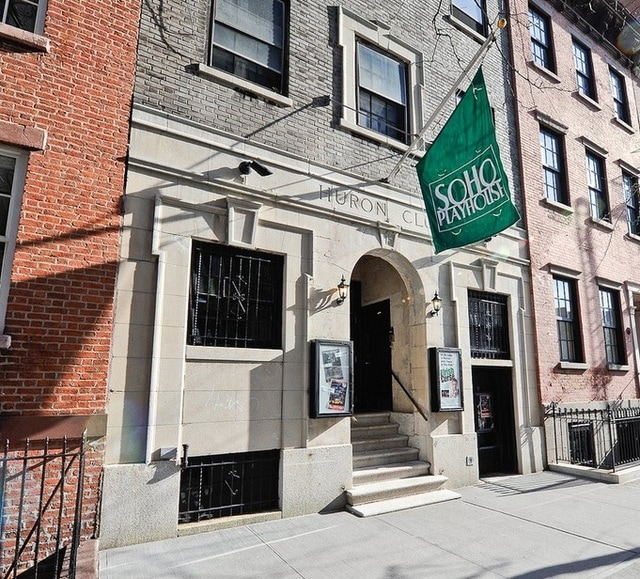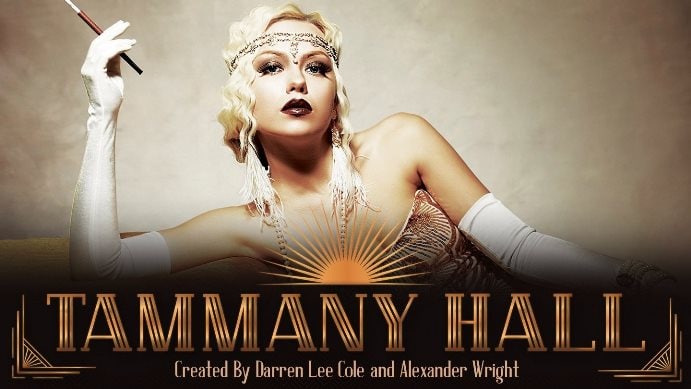For nearly two centuries, the NYC-based political organization Tammany Hall, founded as the Society of St. Tammany in 1786, functioned as the main local political machine of the New York Democratic Party, controlling nominations and political patronage in Manhattan. Tainted by corruption and scandal, it came to a crash on the November 5th election night of 1929, when, with the support of Governor Franklin Delano Roosevelt, anti-Tammany Republican candidate Fiorella LaGuardia challenged Democratic incumbent Jimmy Walker – just as the Roaring ‘20s came to an end in the preceding months of September-October with the Great Stock Market Crash.

Though headquartered in Union Square, the Tammany politicos maintained a clubhouse in each of Manhattan’s electoral districts, including the Huron Club in NYC’s First Ward. First constructed in 1826, on property John Jacob Astor purchased from Aaron Burr, the historic building was reconfigured in 1920, when the main floor’s meeting hall was transformed into a theater, with a notorious clubhouse above, a speakeasy below, and the rumored love nest of Walker and his future wife Betty Compton – an English actress and singer, and member of Broadway’s Ziegfeld Follies revue – in the 4th-floor penthouse. Site of the present-day SoHo Playhouse, the façade still has the Club’s name inscribed in stone above the doorway.
That legendary history is the subject of Tammany Hall, a new site-specific immersive theatrical experience now in previews at Off-Broadway’s SoHo Playhouse, staged throughout fifteen rooms of the landmark Jazz-Age hotspot where much of it happened. The world-premiere work takes audiences on a 90-minute journey back 92 years to the momentous 1929 election night, to eavesdrop and to engage with a roster of such colorful characters as Walker, LaGuardia, Compton, bootlegger and gangster “Legs” Diamond, his gun moll and Follies girl Marion “Kiki” Roberts, and more, as all await the results of that pivotal mayoral race.
I spoke with co-creators and directors Darren Lee Cole (SoHo Playhouse Artistic Director since 2004) and Alexander Wright (multi-award-winning theater maker and director/adaptor of the UK’s longest-running immersive show The Great Gatsby) prior to Tammany Hall’s official opening night on Tuesday, November 2 – the date of NYC’s current hotly contested mayoral election – about the genesis, format, and significance of the show.
How and when did the idea for this originate?
Darren: Because of my association with the building since 2004, and because my other hobby is history, I always wanted to do something that combined the two, specifically the Huron Club’s connection with Tammany Hall. Fast forward to COVID, and I thought maybe we could do this with limited capacity and social distance, rather than with a large audience filling the entire theater. Then I saw Alex’s immersive show The Great Gatsby, which was phenomenal, and realized that we could do something great with this idea, while also meeting pandemic safety protocol.
How did the trans-Atlantic partnership develop between you two, and what specifically is each of you bringing to the production?
Alex: I first met Darren in 2016, when I brought a production to the Fringe Encore series that he created and hosted at SoHo Playhouse. We developed a strong friendship, because we both love theater festivals and love to travel worldwide to see them. In 2019, I did another show at the Playhouse, and the main thing that inspired our partnership was that we got on very well, so we began talking about doing this together as an immersive show.
We brought on the Australian director, actor, and theater-maker Megan Drury [who worked as an originating collaborator, deviser, and performer on Australia’s first and longest running large-scale fully-immersive award-winning theater production A Midnight Visit] as associate director, and the three of us got into the specifics of how it would work. We wanted to get out of our comfort zone – trying to reach the creative award zone! – and our individual skill sets really coalesced.
Darren: Having Alex – a multiple Fringe Encore awardee – bring his work to the Playhouse was a good beginning, but what really sealed the deal was that The Great Gatsby, unlike many other immersive shows, was narratively led, with the audience invited by the characters to follow them through the journey of the plot and sub-plots. This style of storytelling was a perfect match for the Playhouse, with our special interest in inventive and innovative storytelling. And with our historic building, we knew we had the perfect canvas.
The building that houses SoHo Playhouse has undergone many changes in its history, including its recent pre-pandemic refurbishing. Did this show require any additional work on the property to restore the rooms to their authentic 1920s style?
Darren: Extensively! There isn’t a corner that hasn’t been touched, to recreate the real historic look.
Alex: Our set designer Dan Daly and his team have been very specific in choosing authentic paint colors and reimagining the spaces to suit the era and the story, so every inch of the rooms has been addressed. There are two different games here: first, using the features that still exist, in the speakeasy, the home to Tammany Hall, the magic spirit of the penthouse where Walker and Compton stayed; then adding to those narratives by finding spaces, even working with closets and other areas, in which the characters could tell their stories and secrets.

The choice of opening Tammany Hall on our 2021 election night is, of course, relevant to the theme, but are there any other parallels you see between then and now?
Darren: Yes, it’s one of the main motivations for doing this. We’re recreating the election night of 1929, but it’s an important story to tell because of what’s happening today. Three weeks prior to that historic election, the stock market crashed and our society was shaken to its roots. The COVID-19 pandemic has been our crash, and as in the ‘20s, it has given us a unique opportunity to look at societal and political change in our present time. The historical parallels between what happened then and what’s going on today can open people’s minds to change – and that’s not limited to New York.
Alexander: I had to go in and out of being philosophical about the impact of COVID. The ‘20s shift is a paradigm, and that will be the case now. It gives us the opportunity to work towards the greater good. We can reconsider what’s valuable – the inherent value in people – and that a very valuable conversation because society and politics are ultimately about the people.
What do you hope audiences take away from the experience?
Darren: I hope they learn from history and see the opportunity in our current environment; we CAN learn from the past, we CAN influence politics, and we CAN effect change. The world and society are ours. COVID provided a clean slate, and we can splash beautiful colors on it.
The show also provides the opportunity to challenge the power of labels. Tammany Hall was the machine of the Democratic party, LaGuardia was a Republican, who was supported by FDR, a Democrat. We need to divorce ourselves from the structure of those labels and work towards change for the better. Bottom line is that there’s hope.
Many thanks to both of you for an enlightening conversation about the show and its context; I look forward to being immersed in this fascinating piece of NYC history!
Tammany Hall plays through Sunday, January 9, 2022, at SoHo Playhouse, 15 Vandam Street, NYC. For tickets (priced at $69 for previews through November 1, and $89 beginning on November 3), visit the Box Office (Tuesday-Sunday, after 4 pm), or go online. Audience members must be fully vaccinated with an FDA or WHO authorized vaccine and show proof of vaccination and a valid ticket at the time of entry. Mask use is required per current CDC guidelines.






